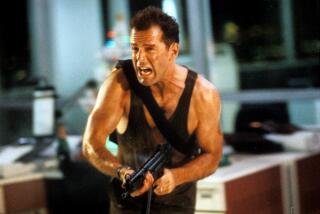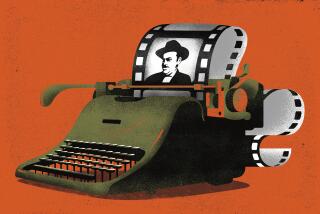Orson Welles, Theatrical Genius, Found Dead at 70
- Share via
Orson Welles, the theatrical genius who panicked the nation with his radio tale of a Martian invasion and later created the classic film “Citizen Kane,” was found dead Thursday in his Hollywood residence. He was 70.
Welles, apparently the victim of cardiac failure, died in an upstairs bedroom of a house in the heart of Hollywood. Los Angeles police said Welles’ body, clad in a bathrobe, was discovered by his chauffeur about 10:30 a.m.
Friends who had dined with him Wednesday in a West Hollywood restaurant said Welles looked pale and gaunt, but seemed cheerful and vital.
Welles, as huge in physical size as in talent, was under treatment for a heart condition and diabetes.
Police said that because his heart condition was known and he had seen a physician about it within the last 20 days, there will be no need for an autopsy.
Welles, best known as the star, writer and producer of the breakthrough motion picture “Citizen Kane,” had been a major figure in the worlds of cinema, theater and radio for nearly five decades. He either performed in, directed, produced, wrote or co-wrote 60 full-length features here and abroad during his long and often stormy career.
Already a celebrated stage actor, he stunned the nation with his shockingly authentic newscast-style version of H.G. Wells’ science fiction fantasy “War of the Worlds” in a radio broadcast Oct. 30, 1938.
For the last decade, he had made what he called “grocery money” by appearing in television commercials--most notably the Paul Masson wine spots in which he made famous the phrase “We will sell no wine before its time.”
His death Thursday brought praise from film industry figures tinged with sadness that Welles’ promise was never quite realized.
“That,” said veteran actor John Houseman, “is absolute bull----.” The careers of Houseman and Welles began to flourish at about the same time in the 1930s, when they were close associates in some highly controversial avante-garde theatrical ventures.
“I worked with Orson some five years,” Houseman said late Thursday. “It was one of the most incredible experiences of my life. I knew for a certainty I was working with a genius--we can look back on his life as extraordinary. He created a number of masterpieces--in the theater the Negro ‘MacBeth,’ in film ‘Citizen Kane’ and many others. . . . The world was not very charitable to him. Maybe if people had been kinder to him, he would have done more.”
Born George Orson Welles on May 15, 1915, in Kenosha, Wis., he was the second son of wealthy parents. His father was an inventor and manufacturer who came from a rich Virginia family. His mother was the former Beatrice Ives, who died when Welles was 8 years old.
On Tour With Father
After his mother’s death, he and his father embarked on a world tour, spending much of their time in Shanghai.
As a child, at the age when most youngsters are just beginning to read, Welles showed a remarkable flair for almost all of the arts--he wrote poetry, painted, acted, played the piano and staged his own productions of Shakespeare.
Welles was raised in Chicago and was educated largely at home until his 11th year, when he entered the private Todd School in Woodstock, Ill. His father died a year later and Welles became the ward of Dr. Maurice Bernstein, a Chicago physician. Welles later used Bernstein’s name for one of the major character’s in “Citizen Kane.”
He graduated from Todd in 1931, decided against college, and set out on a sketching tour of Ireland.
Handsome and already the possessor of a sonorous, naturally dramatic speaking voice, Welles talked his way into a job with an Irish theatrical company, claiming he had starred in New York productions. Although the Irish producers were not taken in by his claims, they did hire him and Welles made his acting debut in Dublin’s Gate Theatre, playing the part of the evil Duke of Wurtemberg in “Jew Suss.” He won good notices, and later appeared in and directed several other plays for the same group.
He returned to the United States in 1932, tried out for several Broadway roles and resumed his travels when he was turned down. He went to Morocco and Spain--where he learned bullfighting--before returning once more to New York and won a role with actress Katherine Cornell’s road company.
Broadway Debut
Welles made his Broadway debut with Cornell in 1934 in “Romeo and Juliet,” playing both the Chorus and Tybalt. In the same year, he married Chicago socialite and actress Virginia Nicholson, co-directed a four-minute motion picture called “The Hearts of Age” and gave his first radio performance.
At about the same time, the young actor met Houseman, then directing the Phoenix Theatre Group. Soon afterward, Welles and Houseman produced and directed for the Federal Theater Project. With Houseman, he formed the Mercury Theatre Project in 1937.
The next year, the troupe evolved into the highly experimental Mercury Theatre of the Air, a weekly radio anthology.
“The War of the Worlds” was intended as a kind of Halloween prank, but the documentary style was so realistic that thousands of listeners panicked and evacuated their homes. Welles was the leading actor in the production, and the script was by Howard Koch.
Largely because of the radio show’s success, he was brought to Hollywood in 1940 by RKO. He began shooting his first feature-length film in July--it was “Citizen Kane,” the movie still proclaimed as his innovative best. He co-wrote (with Herman J. Mankiewicz), directed, produced and starred in the film, which traced the career of an American newspaper tycoon whose life paralleled in many ways that of powerful publisher William Randolph Hearst.
Hearst attempted to suppress the film. Hearst’s star movie columnist, Louella Parsons, tried to get motion picture studios to blacklist Welles--and none of the Hearst publications would print reviews of the film.
The movie has several times been voted the greatest film ever made by panels of cinema critics--and its innovative techniques have influenced generations of film makers who followed. Although the film was a huge critical success, it was not a commercial hit.
Veteran Hollywood columnists and critics said that while Welles was never formally blacklisted, he did become virtually unemployable because of his apparent inability to finish projects such as the films “The Magnificent Ambersons” (1942) and “MacBeth” (1948), which were completed by others.
The last major Hollywood film he directed was “Touch of Evil” in 1957.
During Welles’ later years, he was honored again and again by the film establishment--the Motion Picture Academy, the American Film Institute, the Directors Guild of America and at film festivals all around the world.
“Now I’m just an old Christmas tree, the roots of which have died,” Welles said after receiving a special Oscar in 1970. “They just come along, and while the little needles fall off me, replace them with medallions.”
Honored by the American Film Institute in 1975 as the recipient of the third annual Life Achievement Award, Welles said:
“As a director, I pay myself out of my acting jobs. I use my own work to subsidize my work. In other words, I’m crazy.”
Welles was an enthusiastic eater and a drinker of incredible capacity, according to friends, and was addicted to large, long cigars. He was physically huge--6 feet, 2 inches tall and usually weighed about 300 pounds, although friends said he had dropped about 60 pounds recently.
Attorney Eli Blumefeld, a longtime associate and family spokesman, said Welles had been seeing a doctor for his heart condition for at least the last seven years.
Blumefeld said that Welles had worked “just as hard or harder” in recent commercials as he ever had as a director or producer.
Hollywood was hit hard by Welles’ death--the third superstar to die within a week. Rock Hudson died of AIDS on Oct. 2, and Yul Brynner died from complications of cancer early Thursday.
“These have not been good days,” said actress Janet Leigh, who worked with Welles in “Touch of Evil.” She added: “We all wish we could have made more use of Orson’s genius.”
“It’s no feather in the cap of the Hollywood community that it didn’t make better use of his talents,” said John Huston, one of the great contemporary actor-directors.
Welles was married to actress Rita Hayworth in 1943, with whom he co-starred in “The Lady From Shanghai” (1947), a picture he wrote, directed and produced. They were divorced in 1948.
Welles went into self-exile in Europe not long after the divorce from Miss Hayworth, taking roles in dozens of films, the best-known being the sinister Harry Lime in the 1949 British hit “The Third Man.”
He was married in 1955 to Countess di Girafalco, who acted in Italian films as Paola Mori. It was with Miss Mori that he spent most of his years in Europe. Welles and Miss Mori returned to the United States in 1970, making their home in Las Vegas.
In his frequent trips to Hollywood since then, he had stayed in the four-bedroom hillside house in the 1700 block of North Stanley Avenue where he died.
Welles is survived by Miss Mori and three daughters, Christopher Welles Feder of New York, Beatrice Welles of Scottsdale, Ariz., and Rebecca Welles of Tacoma, Wash. Funeral arrangements are pending.
The theatrical Welles had this comment on death in a recent interview:
“I rejoice in the presence of death because I think it’s what makes life brilliant and beautiful. And without it the world would be ridiculous. I’m interested in it from every point of view. My interest in it has not dimmed with its approach.”
Times staff writers Marylouise Oates and Boris Yaro in Los Angeles and Elizabeth Mehren in New York contributed to this story.
More to Read
The biggest entertainment stories
Get our big stories about Hollywood, film, television, music, arts, culture and more right in your inbox as soon as they publish.
You may occasionally receive promotional content from the Los Angeles Times.










